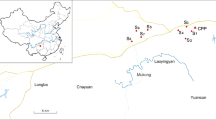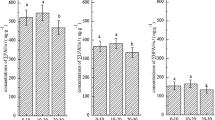Abstract—The content of polycyclic aromatic hydrocarbons (PAH) in Betula nаnа L. and soil organogenic horizons was studied at a control site and sites affected by a thermal power station (TPS) at distances of 0.5, 1, and 1.5 km from the source of pollution. The PAH distribution over the vegetative organs of the dwarf birch was irregular. Different organs of the dwarf birch had similar qualitative composition of PAHs. No significant changes were detected in the PAH content in dwarf birch organs and on the surface of these organs at different distances from the TPS. The PAH content in the organs of plants affected by the TPS was 2–3 times higher than the background value, and the highest excess was found in leaves. The surface PAH concentration on the bark and roots increased threefold under contamination. No excess was revealed in the leaves and branches. The excess over the background value in the soil at contaminated sites was 3–3.5 times with the maximal accumulation at a distance of 1 km. The PAH content in the soil was three times higher than that in the dwarf birch at the control site and 5–6 times that at the contaminated sites. A strong correlation exists between the PAH concentrations in the soil and in B. nana. In the leaves and branches of B. nаnа, the proportion of surface accumulation in the total PAH pool was found to decrease at contaminated sites as compared with the control site. The opposite trend was observed for the bark and roots. Cluster analysis showed a clear separation between the surface and total PAH content in all plant organs under study. Factor analysis of the total PAH content in the organs of the dwarf birch allowed us to determine three main factors affecting the PAH distribution, with the light structures, toxic components, and the other PAHs were allocated in separate groups. Dwarf birch organs can be used as indicators for the contamination level in tundra communities. We suggest using the PAH content in leaves in order to analyze short-term changes in the PAH content and in the bark to assess the long-term impact.



Similar content being viewed by others
REFERENCES
Bashkin, V.N., Barsukov, P.A., and Arabsky, A.K., Specific reaction of biota to environmental pollution in tundra ecosystems, in Biogeochemical Technologies for Managing Pollution in Polar Ecosystems, Environmental Pollution Ser., 2017, vol. 26, pp. 73–85.
Gorshkov, A.G., Mikhailova, T.A., Berezhnaya, N.S., and Vereshchagin, A.L., Accumulation of polycyclic aromatic hydrocarbons in needles of Scots pine in Cisbaikalia, Lesovedenie, 2008, no. 2, pp. 21–26.
Hamid, N., Syed, J.H., Junaid, M., Zhang, G., and Malik, R.N., Elucidating the urban levels, sources and health risks of polycyclic aromatic hydrocarbons (PAHs) in Pakistan: implications for changing energy demand, Sci. Tot. Environ., 2017, vols. 619–620, pp. 165–175.
Kargar, N., Matin, G., Matin, A.A., and Buyukisik, H.B., Biomonitoring, status and source risk assessment of polycyclic aromatic hydrocarbons (PAHs) using honeybees, pine tree leaves, and propolis, Chemosphere, 2017, vol. 186, pp. 140–150.
Li, W., Chen, B., and Ding, X., Environment and reproductive health in china: challenges and opportunities, Environ. Health Perspect., 2012, vol. 120, no. 5, pp. A184–A185.
Li, H., Liu, G., and Cao, Y., Content and distribution of trace elements and polycyclic aromatic hydrocarbons in fly ash from a coal-fired CHP plant, Aerosol Air Quality Res., 2014, vol. 14, pp. 1179–1188.
Liu, S., Liu, Q., and Ostbye, T., Levels and risk factors for urinary metabolites of polycyclic aromatic hydrocarbons in children living in Chongqing, China, Sci. Tot. Environ., 2017, vol. 598, pp. 553–561.
Luttmer, C., Ficko, S., Reimer, K., and Zeeb, B., Deciduous vegetation (Betula glandulosa) as a biomonitor of airborne PCB contamination from a local source in the Arctic, Sci. Tot. Environ., 2013, vol. 445, pp. 314–320.
Ophof, A.A., Oldeboer, K.W., and Kumpula, J., Intake and chemical composition of winter and spring forage plants consumed by semi-domesticated reindeer (Rangifer tarandus tarandus) in Northern Finland, Animal Feed Sci. Tech., 2013, vol. 185, nos. 3–4, pp. 190–195.
Ribeiro, J., Silva, T.F., Filho, J., and Flores, D., Fly ash from coal combustion: an environmental source of organic compounds, Appl. Geochem., 2014, vol. 44, pp. 103–110.
Rodin, L.E., Remezov, N.P., and Bazilevich, N.I., Metodicheskie ukazaniya k izucheniyu dinamiki i biologicheskogo krugovorota v fitocenozakh (Methodological Guidelines for the Study of Dynamics and Biological Turnover in Phytocenoses). Leningrad: Nauka, 1968.
Sahu, S.K., Bhangare, R.C., Ajmal, P.Y., Sharma, S., Pandit, G.G., and Puranik, V.D., Characterization and quantification of persistent organic pollutants in fly ash from coal fueled thermal power stations in India, Microchem. J., 2009, vol. 92, no. 1, pp. 92–96.
Sushkova, S.N., Minkina, T.M., Mandzhieva, S.S., Tyurina, I.G., Vasil’eva, G.K., and Kizilkaya, R., Monitoring of benzo(a)pyrene content in soils affected by the long-term technogenic contamination, Euras. Soil Sci., 2017, vol. 50, no. 1, pp. 95–105.
Tentyukov, M.P., Changes in the information content of the indicative characteristics of tundra shrubs under the conditions of aerotechnogenic pollution, Contemp. Probl. Ecol., 2008, no. 2, pp. 217–224.
Vasilevich, R.S., Beznosikov, V.A., Lodygin, E.D., and Kondratenok, B.M., Complexation of mercury(II) ions with humic acids in tundra soils, Euras. Soil Sci., 2014, vol. 47, no. 3, pp. 162–172.
Verma, S.K., Masto, R.E., Gautam, S., Choudhury, D.P., Ram, L.C., Maiti, S.K., and Maity, S., Investigations on PAHs and trace elements in coal and its combustion residues from a power plant, Fuel, 2015, vol. 162, pp. 138–147.
Yakovleva, E.V. and Beznosikov, V.A., Assessment of indices of tundra phytocoenosis pollution with polycyclic aromatic hydrocarbons, Povolzh. Ekol. Zh., 2016, no. 3, pp. 352–366.
Yakovleva, E.V., Beznosikov, V.A., Kondratenok, B.M., and Khomichenko, A.A., Genotoxic effects in Tradescantia plants (clone 02) induced by benzo[a]pyrene, Contemp. Probl. Ecol., 2011, no. 6, pp. 805–812.
Yakovleva, E.V., Gabov, D.N., Beznosikov, V.A., Kondratenok, B.M., and Dubrovskiy, Y.A., Accumulation of PAHs in tundra plants and soils under the influence of coal mining, Polycyclic Aromatic Compounds, 2017, vol. 37, nos. 2–3, pp. 203–218.
Yakovleva, E.V., Gabov, D.N., Beznosikov, V.A., and Kondratenok, B.M., Accumulation of polycyclic aromatic hydrocarbons in soils and mosses of southern tundra at different distances from the thermal power plant, Euras. Soil Sci., 2018, vol. 51, no. 3, pp. 268–275.
Zubareva, O.N., Estimation of emission discharge range in the impact zone of Norilsk Nikel industrial complex based on analysis of plants, in Materialy Vseros. konf. s mezhdunar. uchastiyem “Evolyutsiya biosfery i tekhnogenez”, VI Vseros. simp. s mezhdunar. uchastiyem “Mineralogiya i geokhimiya landshafta gorno-rudnykh territoriy” i XIII Vseros. chteniy pamyati akademika A.E. Fersmana “Ratsionalnoye prirodopolzovaniye”, “Sovremennoye mineraloobrazovaniye” (Proc. All-Russia Conf. with International Participation “Evolution of the Biosphere and Technogenesis,” VI All-Russia Symp. with International Participation “Mineralogy and Landscape Geochemistry of Ore-mining Territories,” and XIII Readings in Memory of Academician A.E. Fersman “Rational Natural Resource Use” and “Recent Minerogenesis”), Chita: Buryat. Nauch. Tsentr Sib. Otd. Ross. Akad. Nauk, 2016, pp. 202–204.
Zubareva, O.N. and Danilova, I.V., The use of phytoindication for environmental monitoring in the impact zone of Norilsk Nikel industrial complex, in Eklogicheskaya, promyshlennaya i energeticgheskaya bezopasnost’-2017: Mat.-ly Nauchno-prakt. konf. s mezhdunarodnym uchastiem (Ecological, Industrial, and Energy Security-2017: Proc. Sci.-Pract. Conf. with International Participation), Sevastopol: Sevastopol. Gos. Univ., 2017, pp. 51–52.
ACKNOWLEDGMENTS
This work was supported by the Russian Foundation for Basic Research and the Government of the Komi Republic (project no. 16-44-110581 r_a) and by the taxpayerfunded research project no. AAAA-A17-117122290011-5.
Author information
Authors and Affiliations
Corresponding author
Ethics declarations
The authors declare that they have no conflict of interest. This article does not contain any studies involving animals or human participants performed by any of the authors.
Additional information
Translated by E. Kuznetsova
Rights and permissions
About this article
Cite this article
Yakovleva, E.V., Gabov, D.N. Polycyclic Aromatic Hydrocarbons in Betula nana (Betulaceae, Magnoliópsida) under Exposure to a Thermal Power Plant. Biol Bull Russ Acad Sci 46, 1415–1425 (2019). https://doi.org/10.1134/S1062359019100340
Received:
Revised:
Accepted:
Published:
Issue Date:
DOI: https://doi.org/10.1134/S1062359019100340




